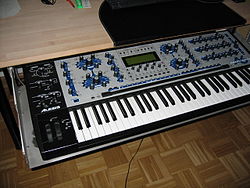Engineering:Alesis Andromeda A6
| Andromeda A6 | |
|---|---|
 Alesis Andromeda A6 (side view) | |
| Manufacturer | Alesis |
| Dates | 2000 – 2010 |
| Price | US$2,499 – 2,999 |
| Technical specifications | |
| Polyphony | 16[1] |
| Timbrality | 16 |
| Oscillator | 2 VCOs per voice 1 sub-oscillator per VCO |
| LFO | 3 dedicated LFOs and S+H |
| Synthesis type | Analog Subtractive |
| Filter | 2 per voice 2-pole resonant multimode - SEM-style 4-pole resonant - Moog-style |
| Attenuator | 3 x 6-stage envelopes |
| Storage memory | 4 x 128 patch internal memory SRAM expansion card slot |
| Effects | Analog distortion + digital fx unit |
| Input/output | |
| Keyboard | 61-note semiweighted Velocity sensitive Aftertouch |
| Left-hand control | Pitch bend and modulation wheels |
| External control | MIDI & CV/Gate |
The Alesis Andromeda A6 (A6 is an acronym: A - A, 6 - SIX, and their consonance corresponds to "ASICs" which is an abbreviation for "Application Specific integrated Circuits") is a 16-voice, 16-channel multitimbral analog synthesizer by Alesis which was released in 2000 and discontinued in 2010.[2] The Andromeda has analog oscillators and filters combined with modern digital control. It can be considered a hybrid of older and newer technologies, but its entire signal path is purely analog. The VCOs have a very practical pitch correction function, a feature missing on other old polysynths. The VCOs have FM and ring modulation and sub-oscillators. These features makes it possible to create a much wider sonic palette than usual on analog polysynths.
Specifications
- Polyphony: 16 voices
- Oscillators: 2 oscillators (with subs) per voice, 5 waveforms available (sine, triangle, pulse, up saw, down saw)
- Filter: 2-pole multimode resonating filter per voice, 4-pole lowpass resonating filter per voice (32 total)
- Effects: Digital reverberation, chorus, echo, analog distortion, quad pitch-shifting, flange, and more
- Arpeggiator: Up, Down, Up/Down
- Sequencer: 16-step, analog style; both have MIDI sync
- Keyboard: 61 keys (velocity and aftertouch sensitive) and a ribbon controller
- Program Memory: 256 preset and 128 user-defined
- Mix Memory: 128 user-defined
- Memory Card Slot: PCMCIA-format
- Control: MIDI (16-parts)
- Date Produced: March 2001 – 2010
- Dimensions (WxHxD): 40.1" x 4.8" x 16.1" (1019 mm x 122 mm x 409 mm)
References
- ↑ "Alesis A6 Andromeda". Sound On Sound. April 2001. http://www.soundonsound.com/sos/apr01/articles/alesis.asp.
- ↑ "Alesis Legacy Products". Alesis. http://www.alesis.com/products/legacy.php.
Bibliography
- "Alesis Andromeda review". Keyboard (May 2001).
- Jenkins, Mark (2009). "The analog revival". Analog Synthesizers: Understanding, Performing, Buying--From the Legacy of Moog to Software Synthesis. CRC Press. pp. 215–216. ISBN 978-1-136-12278-1. https://books.google.com/books?id=iI77AwAAQBAJ&pg=PA194. "In the USA, Alesis, ... announced the Andromeda, again a 'genuine analog' synth. ... Andromeda looked like being one of the most powerful analog synthes available, at US $3000 quite an expensive proposition, but was taken up by Klaus Schulze and others, and at the time of writing is still reasonably easy to find, if not actually in active production."
Further reading
- "Reviews: Alesis A6 Andromeda". Future Music (191): 86–8. September 2007. ISSN 0967-0378. OCLC 1032779031.
External links
 |

